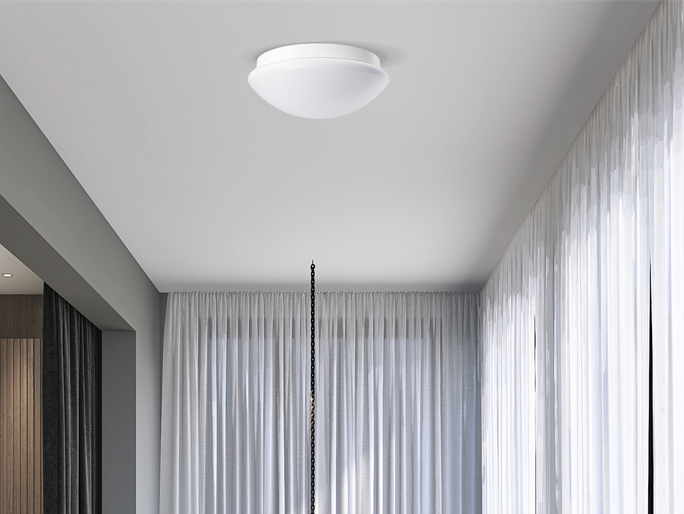

No, ceiling cob light is not better for uniform lighting than regular downlights—in fact, regular downlights (especially those with wide beam angles) are more suitable for creating uniform illumination, while ceiling cob light excels at focused, high-intensity lighting. The key difference lies in their optical designs: regular downlights use diffusers or reflectors to spread light over a wider area, ensuring even coverage across a space. In contrast, ceiling cob light (powered by COB—Chip on Board—LED technology) emits concentrated light with a narrower beam angle, making it ideal for task lighting or accent lighting, not uniform ambient lighting. When designing a balanced lighting system, IMIGY’s products (like Sofing Ceiling Lights for ambient glow and Gloria Ceiling Lights for luxury accents) often pair with regular downlights for uniform coverage, while ceiling cob light serves as a supplementary fixture. Below is a detailed breakdown of their differences and practical applications.

1. Optical Design: Why Regular Downlights Outperform Ceiling COB Light in Uniformity
Regular downlights and ceiling cob light have distinct optical structures that directly impact their ability to create uniform lighting:
Regular Downlights: Most regular downlights (especially recessed or surface-mounted models) feature a wide beam angle (120°–150°) and a diffuser lens. This design spreads light evenly over a large area—for example, a single 10W regular downlight can cover 4–6㎡ of space with consistent brightness, leaving no dark spots. IMIGY’s regular downlights, paired with Sofing Ceiling Lights (a round ceiling light with 120° beam angle), create layered uniform lighting in living rooms or bedrooms. Sofing provides central ambient light, while regular downlights fill in the edges, ensuring the entire space is evenly lit.
Ceiling COB Light: Ceiling cob light uses a compact COB LED chip that emits light in a narrow beam (30°–60°). This concentrated beam delivers high intensity (often 1000–2000 lumens) but covers only 1–2㎡ of space per fixture. For example, a ceiling cob light installed above a kitchen island will brightly illuminate the countertop but leave the surrounding floor relatively dark—great for task lighting, but poor for uniform ambient lighting. To achieve uniformity with COB lights, you would need to install 3–4 times more fixtures than regular downlights, which is costly and creates a "spotlight effect" (bright spots with dark gaps between them).
2. Application Scenarios: When to Choose Each Fixture
The choice between ceiling cob light and regular downlights depends on the lighting goal—uniform ambient lighting or focused task/accent lighting:
Uniform Ambient Lighting (Choose Regular Downlights): For spaces that need consistent brightness (e.g., living rooms, bedrooms, offices), regular downlights are the better choice. In a 20㎡ bedroom, install 4–5 IMIGY regular downlights (10W each, 120° beam angle) in a grid pattern—they’ll work with Gloria Ceiling Lights (installed centrally) to evenly light the entire room. Gloria’s crystal design adds a touch of ceiling decor lights elegance, while the downlights ensure no dark corners near the bed or dressing table.
Focused Task/Accent Lighting (Choose Ceiling COB Light): For areas that need targeted brightness (e.g., kitchen islands, reading nooks, artwork displays), ceiling cob light is ideal. Install a single IMIGY ceiling cob light above a reading chair—its narrow beam will illuminate the book without dazzling the eyes or wasting light on the surrounding floor. In an art gallery or home decor area, use ceiling cob light to highlight paintings or sculptures—its high intensity makes colors pop, while regular downlights provide soft uniform background light to avoid glare.
3. Comparison with Best Ceiling LED Panel Light for Uniformity
If uniform lighting is the top priority, neither ceiling cob light nor regular downlights match the performance of the best ceiling led panel light. Best ceiling led panel light features a large, flat light-emitting surface and edge-lit design, which distributes light across a wide area with exceptional uniformity (uniformity ratio ≥0.8). For example, a single 600mm×600mm best ceiling led panel light (3000 lumens) can cover 8–10㎡ of space with consistent brightness—perfect for offices, classrooms, or large living rooms. Pair the best ceiling led panel light with ceiling cob light for task areas (e.g., office workstations) and ceiling decor lights (e.g., pendant lights) for style—this combination balances uniformity, functionality, and aesthetics.
4. Ceiling Lamp Design: Aesthetic Considerations
While ceiling cob light and regular downlights differ in lighting performance, they also vary in ceiling lamp design, which impacts how they fit into a space’s decor:
Ceiling COB Light: Most ceiling cob light models are compact and minimalist, with a small housing (5–10cm diameter). This makes them ideal for spaces where a low-profile design is desired (e.g., small kitchens, hallways). However, their narrow beam means they’re rarely used as standalone ambient lights—they’re usually paired with other fixtures like Sofing Ceiling Lights to enhance both function and style.
Regular Downlights: Regular downlights come in a variety of designs, including recessed (flush with the ceiling) and surface-mounted (slightly protruding). Recessed regular downlights blend seamlessly with the ceiling, creating a clean, modern look—great for contemporary homes or offices. Surface-mounted regular downlights often have decorative trims (e.g., chrome, matte black), adding a subtle design element that complements ceiling decor lights like chandeliers or pendant lights.
Ceiling cob light is not better for uniform lighting than regular downlights—regular downlights (with wide beam angles) are designed for even coverage, while ceiling cob light is built for focused, high-intensity lighting. For spaces that need uniform ambient lighting (e.g., living rooms, bedrooms, offices), choose regular downlights or the best ceiling led panel light (for maximum uniformity). For task or accent lighting (e.g., reading nooks, artwork displays), ceiling cob light is the superior choice. IMIGY’s lighting ecosystem—including Sofing Ceiling Lights (ambient glow), Gloria Ceiling Lights (luxury accents), regular downlights (uniform coverage), and ceiling cob light (targeted brightness)—lets you create a customized system that meets both functional and aesthetic needs. By understanding their strengths and limitations, you can select the right fixtures to achieve the perfect lighting for any space.
It is recommended that you upgrade the latest browser
 Chrome
Chrome Firefox
Firefox Edge
Edge